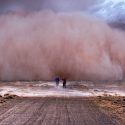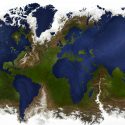Sand dunes. These breathtaking, gigantic structures formed by tiny grains of sand are beautiful – until you’re being swallowed by one. Deserts are dangerous. If you don’t watch your step, you could end up buried alive.
A dune is a mound of sand formed when the wind blows grains of sand into a sheltered area. Dunes have a slip face, the side that’s sheltered from the wind, and a windward side where the wind pushes material. When the slope becomes greater than 34 degrees, gravity pulls the loose sand down, causing slumping.
Sand dunes are marketed as tourist destinations. But sand is an unstable substance that can collapse quickly without any warning, swallowing people in seconds. Nothing says your vacation is over like being trapped in a dune that’s 0.5 km (0.3 mi) high, huh?
Has anyone survived being buried by sand? Why shouldn’t you try to dig yourself out of a dune? What animals could be hiding in the sand with you?
Step 1. Keep the sand outside your body
The biggest dunes can have nearly 5 billion m² (169.5 billion ft²) of sand. If you find yourself trapped inside a dune, try to stay quiet and calm. Every orifice of your body will be bombarded by grains of sand. And breathing heavily or screaming will help sand enter your lungs faster, which is painful and dangerous.
Step 2. Preserve your oxygen
Mount Baldy, in Indiana, is 38 m (125 ft) high. In 2013, this huge sand dune swallowed a six-year-old. The boy fell 3.3 m (11 ft) into the sand and remained buried for more than three hours. He only survived because an air pocket formed around him as the sand was collapsing. Even if you’re as lucky as Nathan and have air to breathe, you’ll need to preserve it. Don’t do anything that would use up your oxygen supply quickly, like making intense movements.
Step 3. Close your eyes
Sand dunes are found in deserts and on beaches, and they’re different. Dunes near the ocean are stationary since the water cements them in place. But in a desert, the dunes travel with the wind, which presents another threat. Wind-blown sand can cause blindness and disorientation. And a dune’s nature is hazardous enough with your two eyes working. If you want to preserve them, you’ll need to keep your eyes closed.
Step 4. Don’t dig
This might sound counterintuitive. But if the sand is fresh, it will fill back in wherever you push it away. If you try digging yourself out, you could end up buried even further down inside the dune.
Step 5. Make sure people know where you are
Some animals can live inside dunes. The sandfish, a type of lizard, can retract its legs and move through the sand. A few species thrive in this environment, but you’re not one of them. If a dune swallows you, it would be tough to find you quickly if people don’t know your location. Always tell people exactly where you’re going, so they can send help if you don’t return.
Sources
- “Dune”. Jenny Hogan. National Geographic Society.
- “Mystery of world’s tallest sand dunes solved”. Hogan, Jenny. 2021. New Scientist.
- “‘Miracle’ boy survives three hours underground after being swallowed by massive sand dune”. 2021. nationalpost.com.
- “Rotting Wood Responsible For Sand Dune Holes?“. GENEVIEVE BOOKWALTER 2021. Science.
- “How Much Sand – Great Sand Dunes National Park And Preserve”. 2021. handsontheland.org.



























